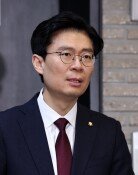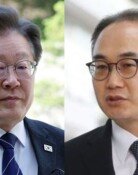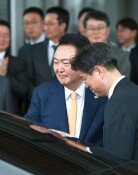Is the U.S. nuclear umbrella truly reliable?
Is the U.S. nuclear umbrella truly reliable?
Posted September. 13, 2016 07:29,
Updated September. 13, 2016 07:29
Two Rockwell B-1 Lancers, the strategic supersonic bombers of the U.S., are going to fly over the South Korean skies in a saber-rattling campaign against North Korea’s fifth nuclear test. The measure is part of the extensive deterrence strategy in which the U.S. makes a full use of its strategic assets to protect South Korea with the security level on mainland U.S. While the U.S. had planned to send the bombers flying over the Korean Peninsula on Sunday, the plan was postponed due to the strong side wind in the Guam naval base. Having been forward-deployed from mainland U.S. to Guam in August, the B-1 Lancer bomber, which is equipped with 24 nuclear bombs and flies at the speed of Mach 1.2, can reach the peninsula in two hours, an hour faster than the B-52 bombers.
Just sending the bombers, the ace in the hole for the U.S.’s potential all-out nuclear warfare, hovering under the skies of Osan City alone has the effect of deterring nuclear provocations from North Korea. However, the initial plan to send them over was canceled for a bad weather condition, and it raises the serious concern that the joint response of the U.S. and South Korea may not been nimble enough to counter actual threats from the North. How are we going to cope should the North make provocations in a bad weather? In addition, it cannot be guaranteed whether the U.S. will send additional forces to Korea without any hesitation even when its naval base is threatened by North Korea’s ballistic missiles loaded with nuclear warheads.
That the South Korean military has revealed the Korea Massive Punishment & Retaliation plan aimed at annihilating the palace of the North Korean leader in Pyeongyang reflects the stark reality that it has no effective means to deter North Korea’s nuclear attacks for now. South Korea’s nuclear development is in violation of the NPT and the principle of denuclearization of the Korean Peninsula, whose importance the South Korean government has stressed repeatedly in denouncing North Korea’s nuclear development. The U.S., South Korea’s ally, will never agree, and it is unrealistic to pursue something that will accompany massive, diplomatic and economic sanctions.
A fine alternative will be introducing the strategic nuclear weapons back in Korea, which was pulled out in 1991 by the U.S. It is worth noting that South Korea could be made part of the “NATO nuclear sharing scheme,” in which the U.S. deploys tactical nuclear warheads in NATO allies and load them on the fighter jets of the allies in case of contingencies. While it is in violation of the joint declaration of denuclearization of the Korean Peninsula, an inter-Korean pact signed in 1992, now that the North has almost reached the final development stage of nuclear weapons, the declaration is as good as scrapped.
Having completed the preparation for the sixth nuclear test, the North is further digging in its heels to become a nuclear state. Both the U.S. and South Korea must consider all possible options and closely make a strategic review on them. South Korea needs to outwit North Korean leader Kim Jung Un by coming up with a preemptive countermeasure lest it should let its fate be swayed by North Korea’s nuclear weapons.
한기흥기자 eligius@donga.com







